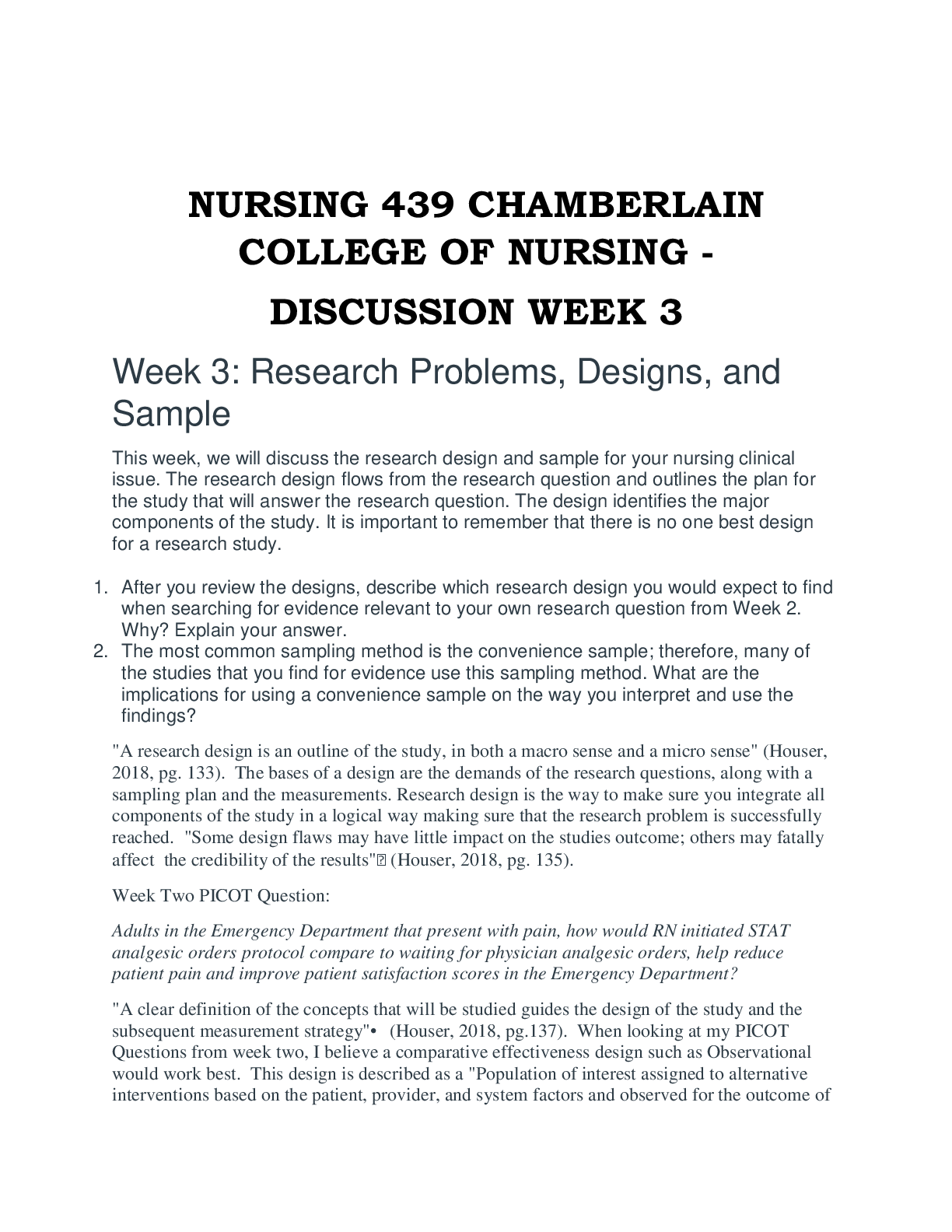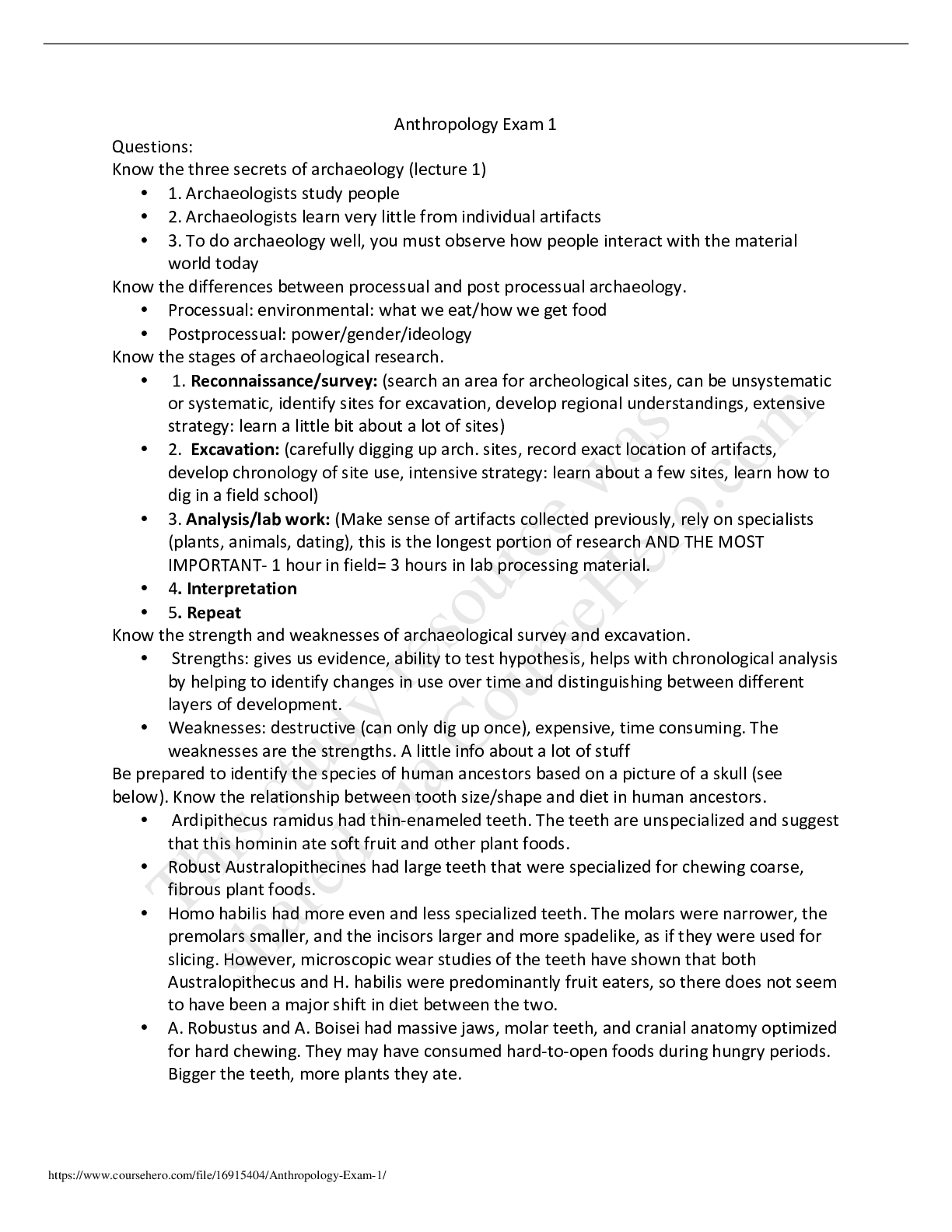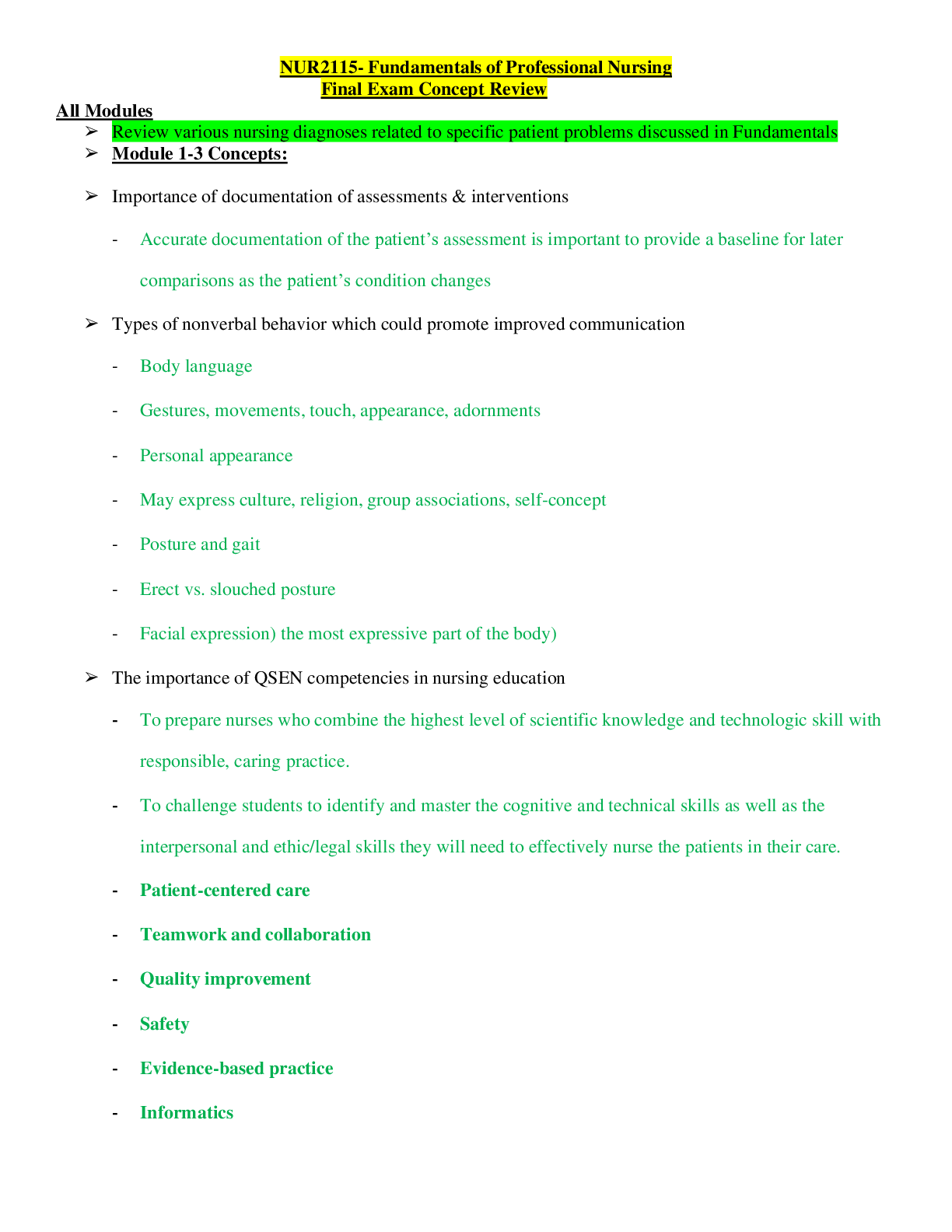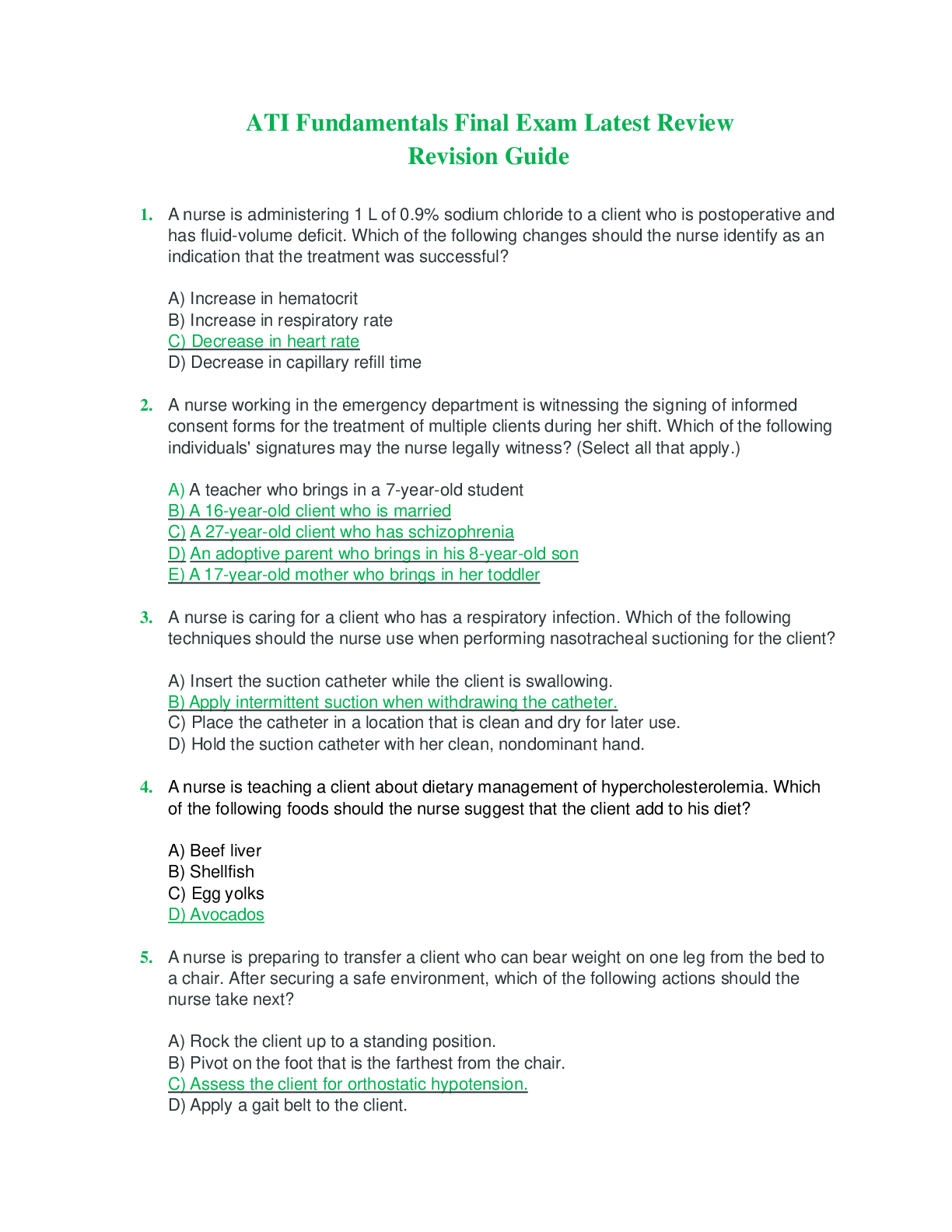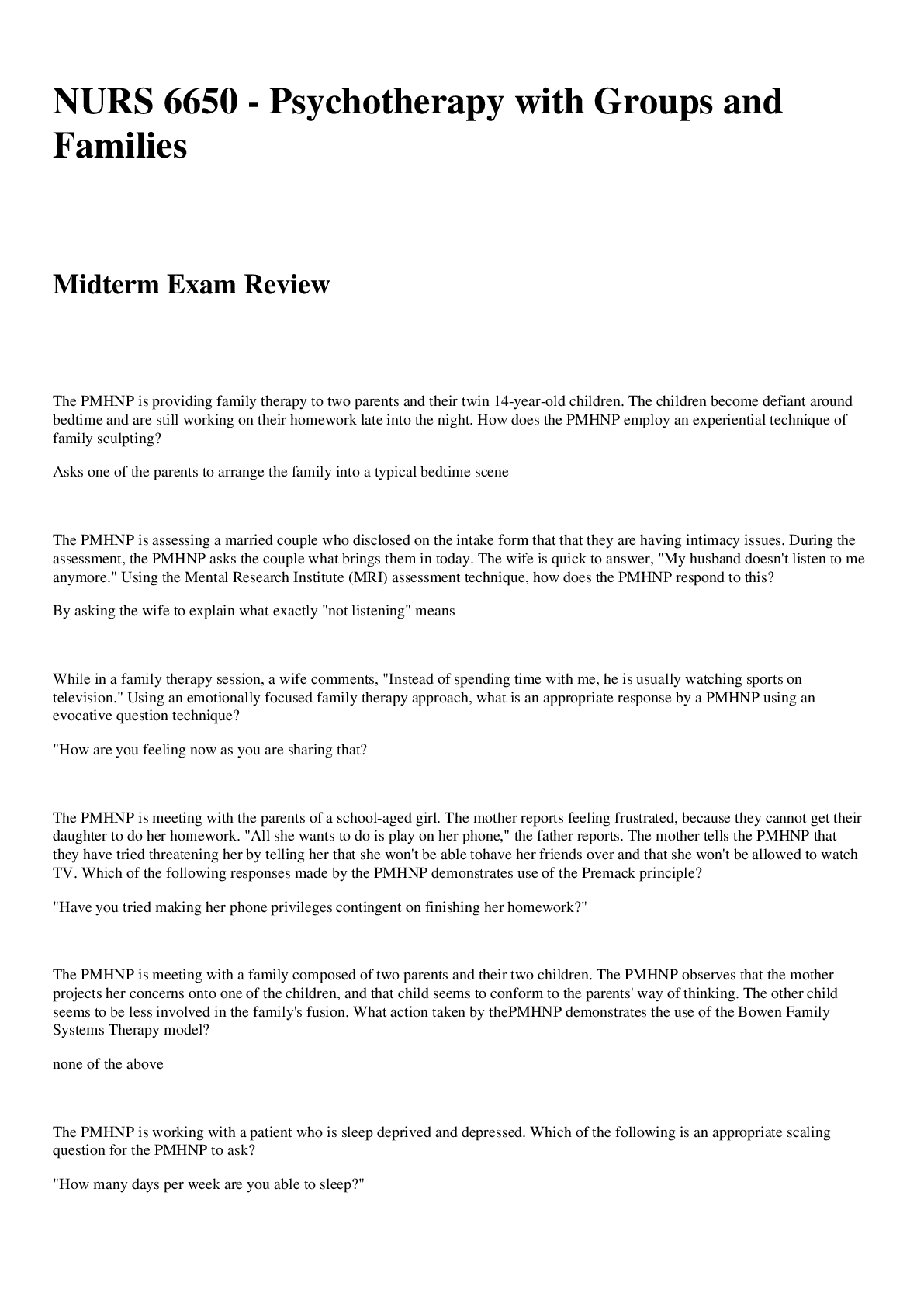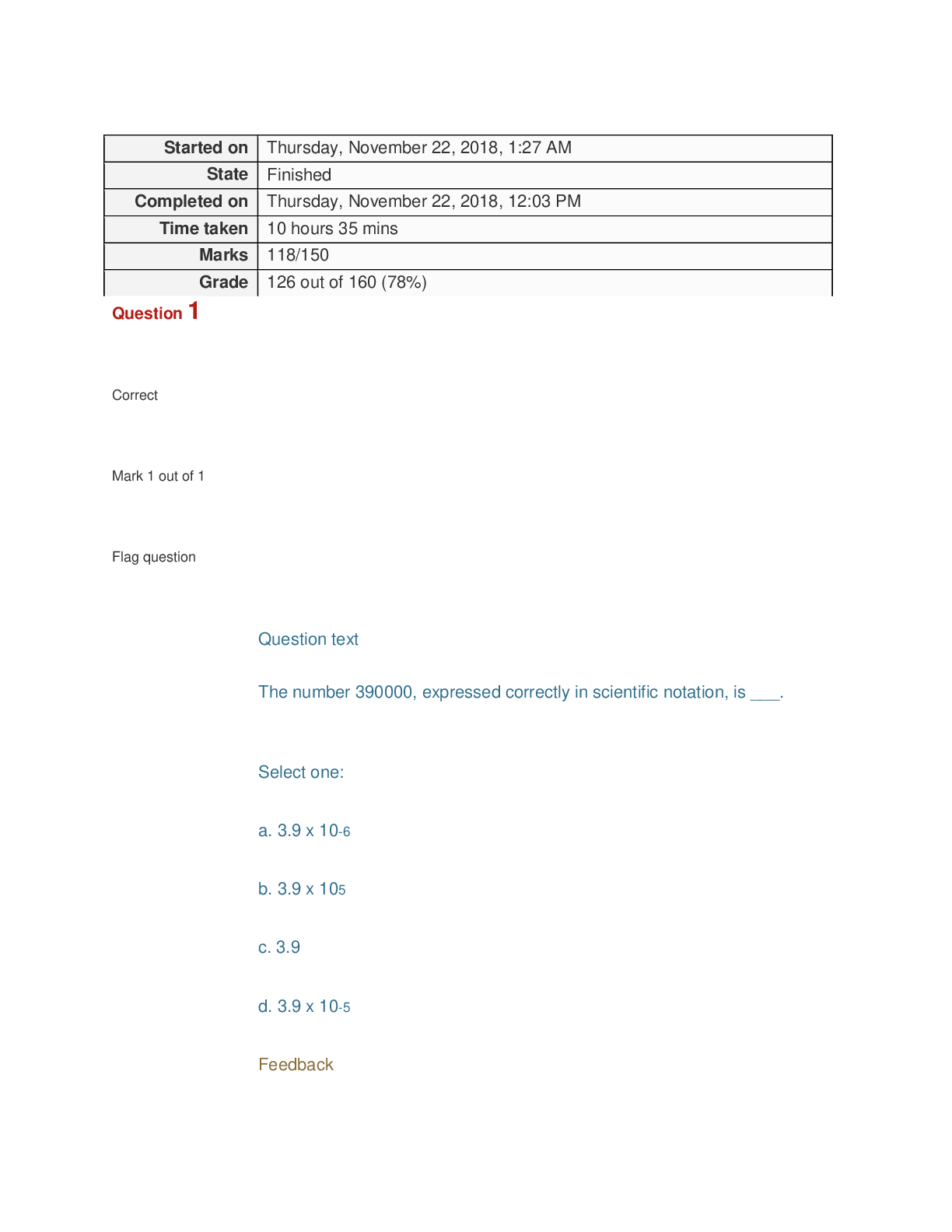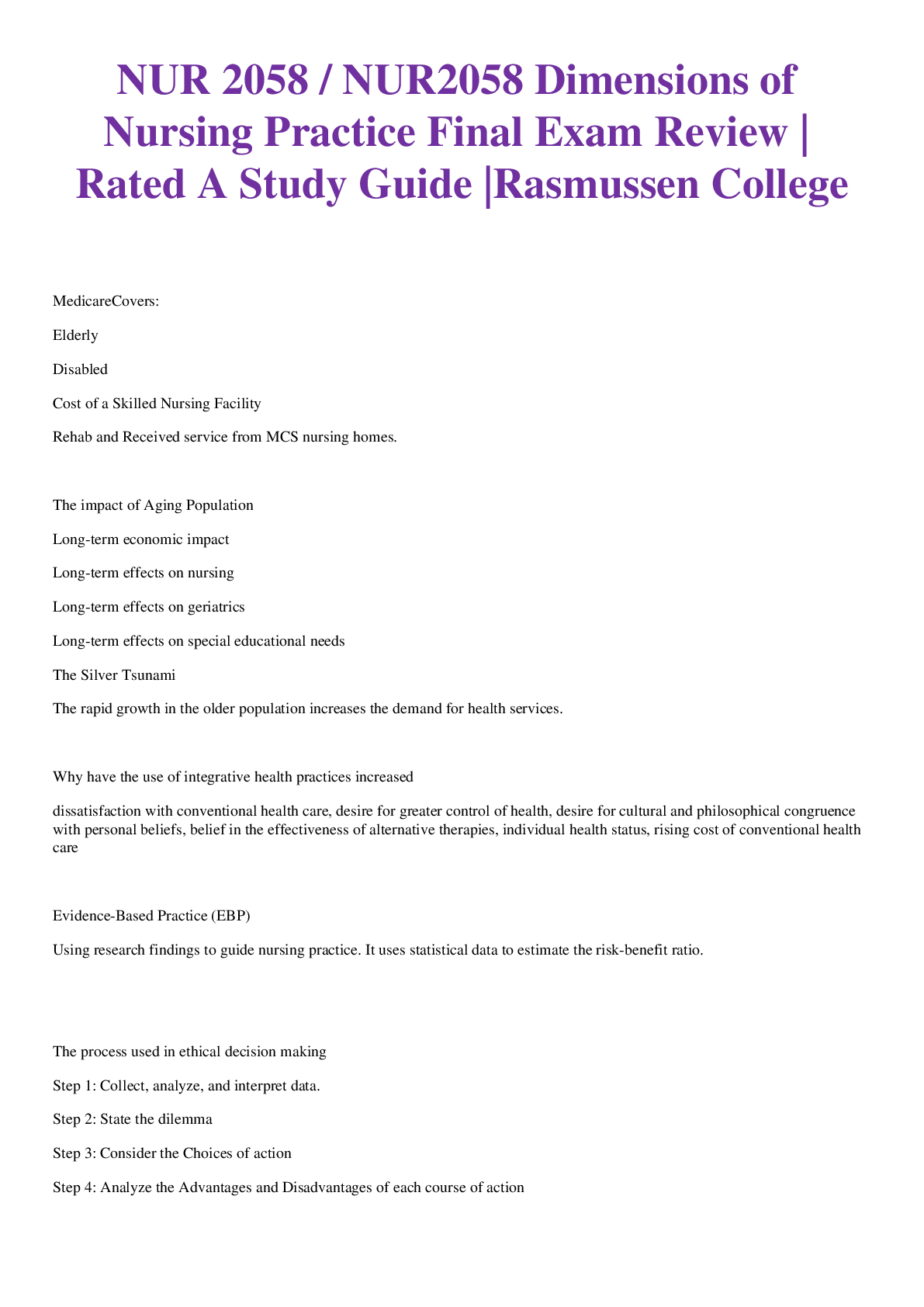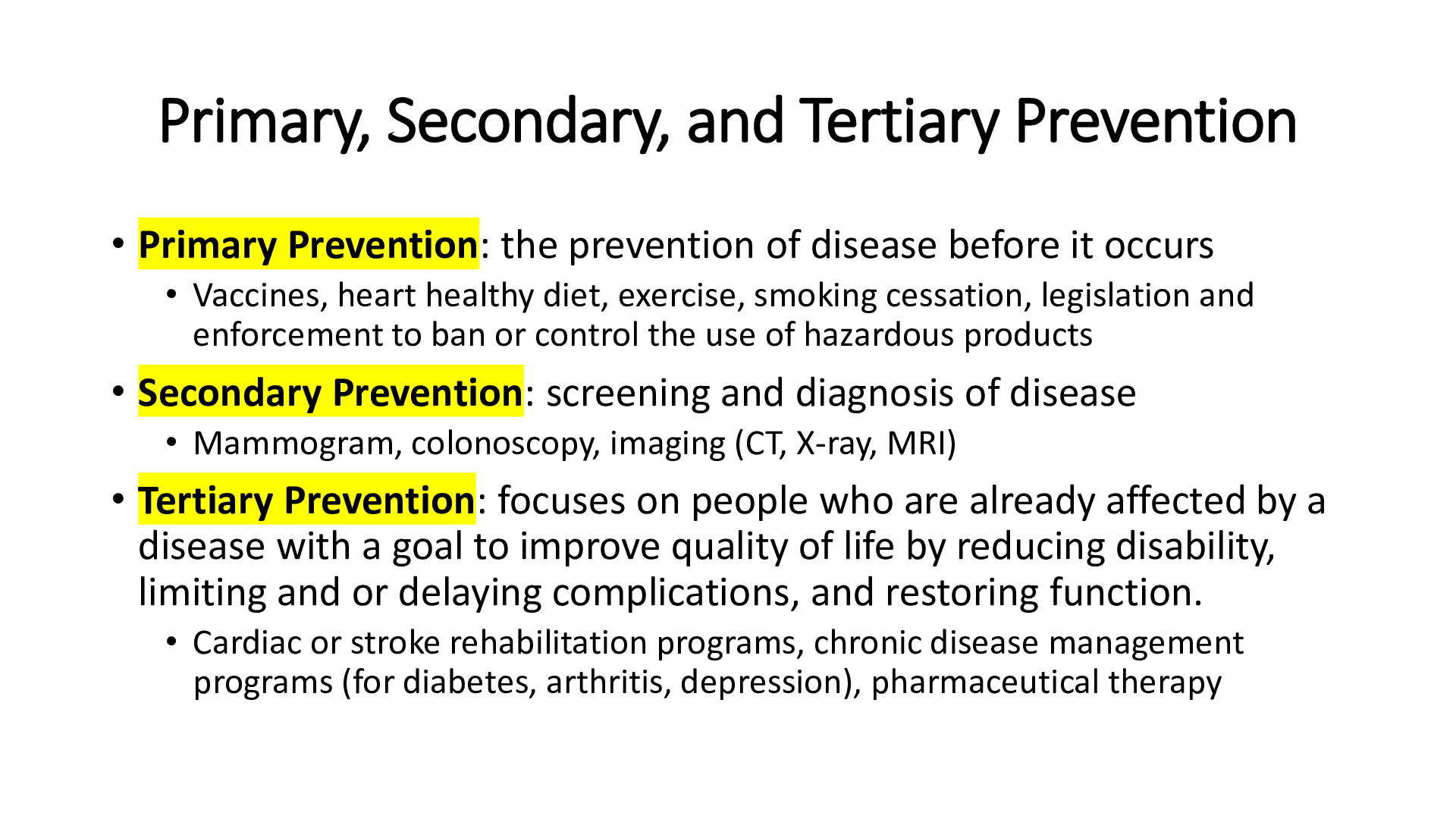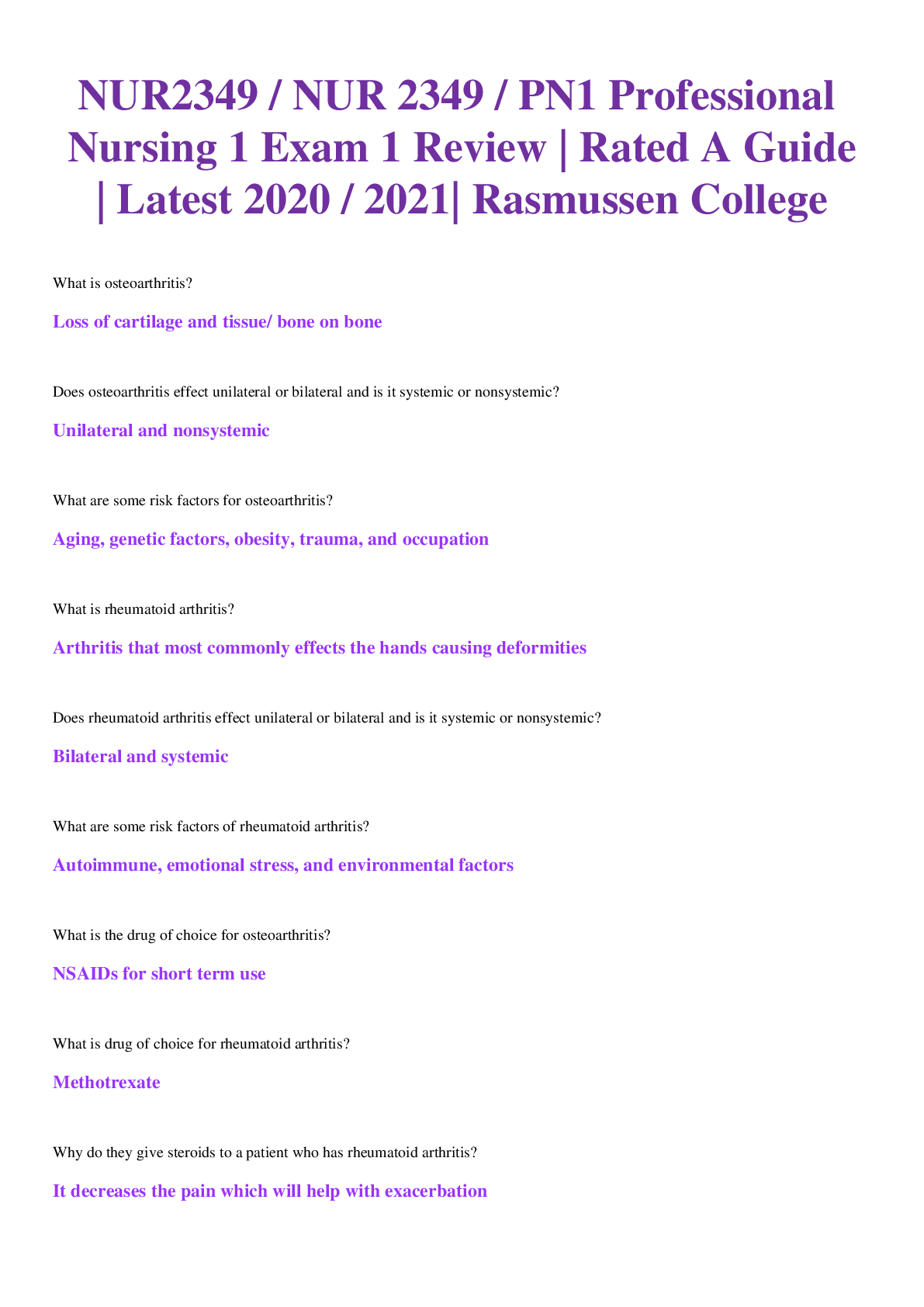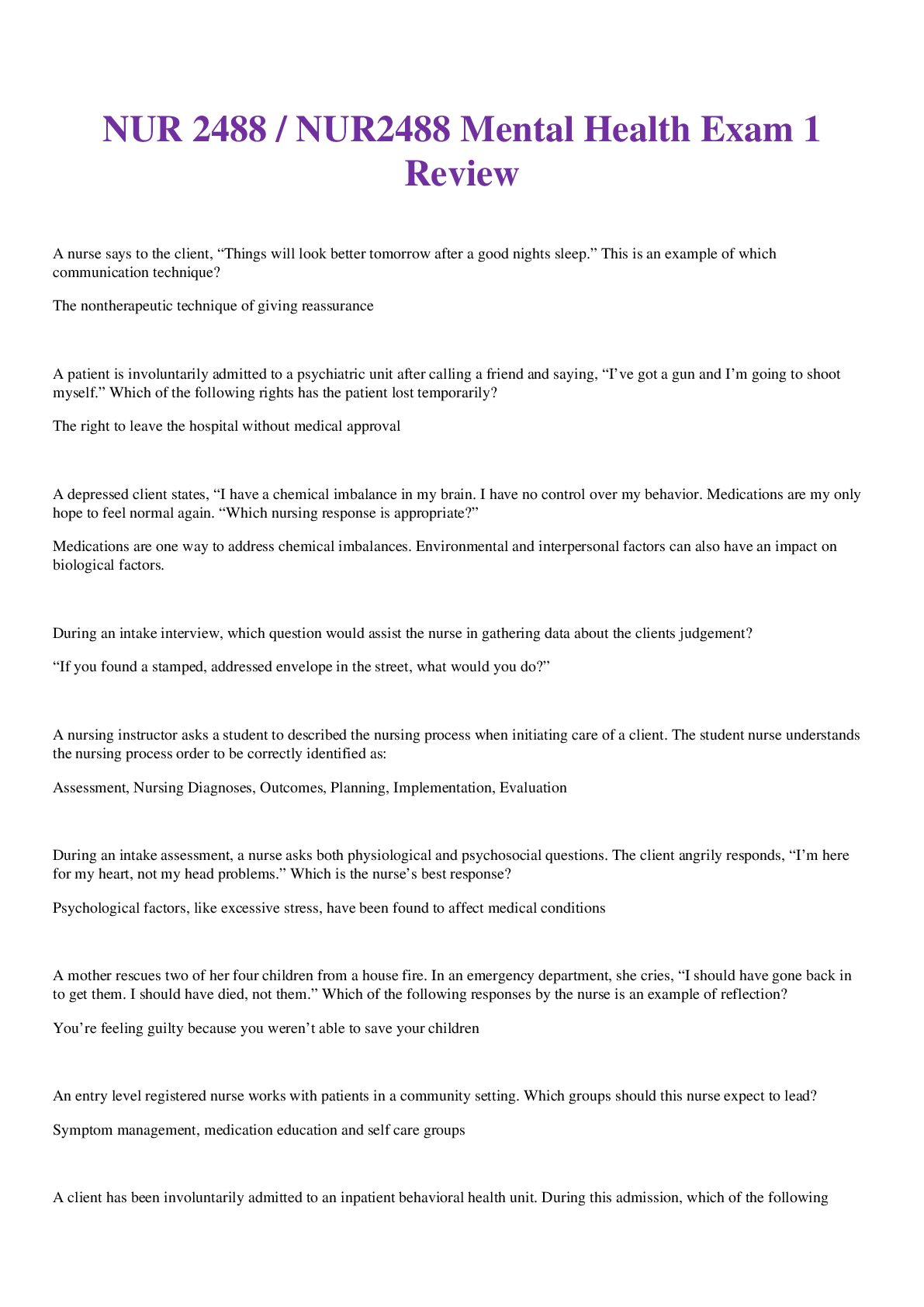*NURSING > EXAM REVIEW > NUR 1022C Fundamentals Final Review (All)
NUR 1022C Fundamentals Final Review
Document Content and Description Below
NUR 1022C Fundamentals Final Review Fundamentals Final Review Question 1 A nurse manager has a staff nurse who observes certain religious holidays. The manager tries to make sure that these obse... rvances can be met if possible. Which value is the manager practicing? 1. Human dignity 2. Social justice 3. Autonomy 4. Altruism Question 2 Parents of a terminally ill child have decided to remove their child from life support, a decision that has met with little positive support. Which nursing action demonstrates autonomy regarding the parents’ decision? 1. Showing respect for the family 2. Respecting the parents’ decision 3. Referring the parents to social services 4. Asking to be assigned to a different client Question 3 A client has chosen to discontinue hemodialysis. His family is not supportive of his decision. Which statement should the nurse make that demonstrates the theory of principles-based reasoning? 1. “This client is of sound mind and is capable of making his own decisions regarding health care. It really is his decision to make.” 2. “I need to try and help the family understand the client’s decision so they can work through this situation together.” 3. “This client’s health is so deteriorated that the treatment is not saving his life. It is prolonging the ultimate outcome, which is his death.” 4. “The client understands his decision and the advanced stage of his disease. If he quits treatment, he will die.” Question 4A decision has been made for an older client to receive aggressive cancer therapy despite knowing that the therapy will actually be more harmful than the disease and subject the client to harmful chemicals. With which ethical principle is this nurse caring for this client struggling? 1. Autonomy 2. Justice 3. Beneficence 4. Nonmaleficence Question 5 When completing a community assessment, the community health nurse will take several aspects into account. What is the first stage of this assessment that the nurse will complete? 1. Learn about the people in the community. 2. Understand the major illnesses present in the community. 3. Identify the boundaries of the community. 4. Make sure resources are available in the community. Question 6 A public health nurse is working with a group of home health nurses in an isolated, mountainous region where access to smaller communities and individuals is quite difficult, especially in the winter and early spring—seasons when the health needs of these individuals are quite high. The public health nurse has set up video conferencing and video clinics for these home health nurses regarding various client teaching and health promotion activities. What activity did the public health nurse conduct? 1. Community-based nursing 2. Parish nursing 3. Telenursing 4. Collaborative health care Question 7 The nurse is providing care to a group of clients. For which situation would the nurse’s use of critical thinking be a priority? 1. Administering IV push meds to critically ill clients 2. Educating a home health client about treatment options 3. Teaching new parents car seat safety4. Assisting an orthopedic client with the proper use of crutches Question 8 A client is experiencing a productive cough, audible coarse crackles, elevated temperature of 102.3°F, chills, and body aches. What did the nurse use to determine that this patient is experiencing respiratory compromise? 1. Deductive reasoning 2. Inductive reasoning 3. Socratic questioning 4. Critical analysis Question 9 The nurse who just moved from an urban area to a sparsely populated rural area understands that certain customs and practices the nurse follows may be quite foreign to the people in the new area. Which attitude of critical thinking is the nurse demonstrating? 1. Fair-mindedness 2. Insight into egocentricity 3. Intellectual humility 4. Intellectual courage to challenge the status quo and rituals Question 10 The nurse implements a quicker way to set up and initiate an intravenous infusion while still following safe practice. Which attitude of critical thinking is this nurse practicing? 1. Independence 2. Intellectual courage to challenge the status quo or rituals 3. Integrity 4. Confidence Question 11 The student is learning the steps of the nursing process. What is the first thing that the student should realize about the purpose of this process? 1. Deliver care to a client in an organized way.2. Implement a plan that is close to the medical model. 3. Identify client needs and deliver care to meet those needs. 4. Make sure that standardized care is available to clients. Question 12 The nurse provides a back rub to a client after administering a pain medication with the hope that these two actions will help decrease the client’s pain. Which phase of the nursing process is this nurse implementing? 1. Assessment 2. Diagnosis 3. Implementation 4. Evaluation Question 13 The nurse is admitting an infant to the care area. The parents and grandmother are present. What should the nurse use as the best source of data for this client? 1. Medical record from the child’s birth 2. Grandmother 3. Parents 4. Admitting physician Question 14 The nurse documents: “Client avoids eye contact and gives only vague, nonspecific answers to direct questioning by the professional staff. Is quite animated (laughs aloud, smiles, uses hand gestures) in conversation with spouse.” Which method of data collection does this documentation demonstrate? 1. Examining 2. Interviewing 3. Listening 4. Observing Question 15A discharge goal for a client is to have improved mobility. Which outcome statement did the nurse write appropriately? 1. Client will ambulate without a walker by 6 weeks. 2. Client will ambulate freely in house. 3. Client will not fall. 4. Client will have freer movement in daily activities. Question 16 The nurse is reviewing interventions written for a client’s plan of care. Which intervention should the nurse recognize as being dependent? 1. Repositioning the client every 2 hours 2. Assisting the client with transfers to the bathroom 3. Providing ongoing physical assessment, especially of the incisional sites 4. Administering medications for pain Question 17 The nurse identifies the diagnosis Risk for aspiration, related to neuromuscular dysfunction for a client who experienced a cerebrovascular accident. Which intervention should the nurse identify as including a rationale? 1. Have suction equipment available at all times. 2. Clear secretions from oral/nasal passageways as needed. 3. Keep client in low-Fowler’s position to prevent reflux. 4. Provide frequent assessment for presence of obstructive material in mouth and throat. Question 18 A client who is being transferred to a rehabilitation center asks the nurse if he can take his chart with him, as it’s his record. How should the nurse respond to this client’s request? 1. “You’ll have to ask your doctor for permission to do that.” 2. “Actually, the original record is the property of the hospital, but you are welcome to copies of your records.” 3. “We’ll make sure that all of your records are sent ahead to the rehab hospital, so you don’t really have to worry about those details.”4. “There’s a new law that protects your records, so you’re not going to be able to have access to them.” Question 19 After classroom discussion regarding confidentiality policies and laws protecting client records, a student asks why it’s permissible for them to review and have access to client records in the clinical area. How should the nursing instructor respond? 1. “Confidentiality and privacy laws don’t apply to students.” 2. “Most students review so many records and charts that they could not possibly remember details from any one of them.” 3. “Records are used in educational settings and for learning purposes, but the student is bound to hold all information in strict confidence.” 4. “As long as the clinical instructor is in the area, accessing client records is part of the education process.” Question 20 The client states: “I really don’t want anyone to visit me who has not been cleared by me first.” If utilizing SOAP format, in which category should the nurse document this statement? 1. Subjective data 2. Objective data 3. Assessment 4. Planning Question 21 A client did not meet the goal of walking unassisted, without assistive devices, by discharge from rehabilitation. The case manager using a critical pathway should identify this outcome as being which of the following? 1. An unattainable goal 2. A variance 3. An error in care planning 4. An error in intervention implementation Question 22When responding to a call light, the nurse finds a client lying on the floor, with the bed linens around the legs. Which chart entry should the nurse document for this finding? 1. Client fell out of bed, but did push the call button for assistance. 2. Client became tangled in the bed linens, then called for assistance after falling out of bed. 3. Recorder responded to client’s call light, upon entering the room, found client on floor. 4. Client found on floor, appeared to have fallen out of bed as a result of getting tangled in bed linens. Question 23 A nurse is working in a rehabilitation center with a client who had a serious injury. Part of the client’s care plan includes working on coping with her current limitations since the injury. This nurse is working within which model of health? 1. Role performance 2. Adaptive 3. Eudemonistic 4. Clinical Question 24 During a home visit with a new community member, the nurse suspects that a client has a chronic illness. What did the nurse assess to make this clinical decision? Select all that apply. 1. Experienced symptoms for 8 months 2. Has periods where the symptoms disappear 3. Altered activities of daily living because of the illness 4. Problem disappeared with over-the-counter medication 5. Symptoms appeared abruptly and disappeared after treatment Question 25 A community health nurse is learning about the REACH initiative and has decided to implement community education on this approach. What topics should the nurse include in this education? Select all that apply. 1. Child and adult immunizations 2. Cardiovascular disease 3. Chronic lower respiratory disease4. Stroke 5. Infant mortality Question 26 A client is the child of an African American father and Asian American mother. The client has been exposed to cultural foods, traditions, and customs from both parents throughout life. What term should the nurse use to describe this client’s cultural development? 1. Diversity 2. Subculture 3. Multicultural 4. Cultural sensitivity Question 27 A client has requested that she have a special item present in her room and explains that it gives her a feeling of comfort and a sense of organization. On which psychosocial component is this client focusing? 1. Culture 2. Religion 3. Ethnicity 4. Socialization Question 28 A client makes the following statement: “I must be paying for all the wrongs I did in my life, to have such a diagnosis as this.” The nurse suspects that this client views health from which type of belief? 1. Magico-religious belief 2. Holistic health belief 3. Biomedical health belief 4. Folk medicine Question 29 The school nurse is conducting head lice screenings. Before checking the head of an Asian child, the nurse should first take which action? 1. Ask permission.2. Make sure the child understands the reason for the contact. 3. Put gloves on. 4. Ask the child to wait until last, to avoid embarrassing the child. Question 30 The nurse is teaching a client from a culture that is “present oriented” about a dressing change that should be performed twice a day. How should the nurse address the cultural issue? 1. Allow the client to select the times the dressing will be changed. 2. Instruct the client to change the dressing after breakfast and before going to bed. 3. Explain that the client should complete the dressing change at 10 AM and 4 PM. 4. Suggest that the dressing change can be performed whenever the client chooses, as long as it gets done twice daily. Question 31 The nurse is planning care for an older adult client. On what should the nurse focus if following the Functional Consequences Theory on aging? Standard Text: Select all that apply. 1. Promote safety. 2. Promote mental health. 3. Improve quality of life. 4. Promote spiritual health. 5. Promote growth and development. Question 32 A group of elderly women come to the community center for exercise classes taught by the community health nurse. This activity will help lead to which outcome for these clients? 1. Reverse the effects of aging and cure pain. 2. Slow bone density loss and decrease muscle atrophy. 3. Eliminate the risk for osteoporosis. 4. Prevent pathologic fractures.Question 33 A nurse explains to a client that he will need to have a bowel prep before going to his esophagogastroscopy. On what should the nurse focus to improve communication skills? 1. Pace 2. Intonation 3. Simplicity 4. Clarity Question 34 The nurse enters a client’s room and finds that the telephone is lying in the client’s lap, tissues are wadded up on the bed, and the client’s eyes are red and watery. What is the best response by the nurse? 1. “Can I hang that phone up for you?” 2. “Well, it’s a beautiful day outside. Let’s open the blinds.” 3. “Has your doctor been in to talk to you yet?” 4. “You look upset. Is there anything you’d like to talk about?” Question 35 A nurse is working in a pediatric clinic and has to explain a nebulizer treatment to a child. Which approach should the nurse use? 1. Give the child’s parent a full explanation, but make sure the child hears what is said. 2. Let the child handle the equipment first, then demonstrate on the child’s doll. 3. Start the treatment, but make sure that the parent is there to comfort the child if she becomes afraid. 4. Make sure that the physician is available for questions. Question 36 A nurse enters a client’s room and asks about his level of pain. The client, grimacing, says “It’s fine.” Which communication factor is the client struggling with? 1. Territoriality 2. Environment 3. Congruence 4. AttitudeQuestion 37 The nurse is conducting an admission interview. Which response indicates that the nurse is attentively listening to the client’s explanations? 1. “Can you explain what your symptoms are like?” 2. “When was the last time you saw a doctor for this?” 3. “Uh-huh,” while nodding the head 4. “I’m sorry, say that again?” Question 38 The nurse is identifying communication strategies for a client unable to speak. What would be appropriate for the client in this situation? 1. Using a picture board to facilitate communication 2. Facing the client when speaking 3. Employing an interpreter 4. Making sure that the language spoken is the client’s dominant language Question 39 The nurse wants to gain information about a client’s situation. Which question should the nurse use to maximize communication with this patient? 1. “What brings you to the hospital?” 2. “Are you having pain?” 3. “Does your pain feel better or worse today?” 4. “Is there anything I can do for you?” Question 40 The nurse is preparing to perform a health assessment of the abdomen. In which order should the nurse perform the assessment? 1. Auscultate, percuss, palpate, inspect 2. Inspect, auscultate, palpate, percuss 3. Inspect, auscultate, percuss, palpate4. Palpate, percuss, auscultate, inspect Question 41 The nurse is performing a health assessment and notes a yellow tinge to the sclera of the eye. The nurse should document this as being 1. cyanosis. 2. jaundice. 3. pallor. 4. erythema. Question 42 While performing an assessment of the integument system, the nurse notes the client’s eyeballs are protruding and the upper eyelids are elevated. What term should the nurse use to document this finding? 1. Erythema 2. Cyanosis 3. Exophthalmos 4. Normocephalic Question 43 The nurse is performing a lung assessment on a client with suspected pneumonia. Which finding should the nurse report to the physician immediately? 1. Chest symmetrical 2. Breath sounds equal bilaterally 3. Asymmetrical chest expansion 4. Bilateral symmetric vocal fremitus Question 44 The nurse is caring for a client following a cerebrovascular accident (stroke). The client is able to comprehend what is being said to him; however, he is unable to respond by speech or writing. What type of aphasia should the nurse realize this patient is demonstrating? 1. Auditory aphasia 2. Acoustic aphasia3. Sensory aphasia 4. Expressive aphasia Question 45 The nurse is preparing the morning assignments. Which assessment could the nurse delegate to unlicensed assistive personnel? 1. Neurological assessment 2. Musculoskeletal assessment 3. Vital signs assessment 4. Female genital assessment Question 46 The nurse is preparing to administer a cardiotonic drug to a client. Which assessment should the nurse perform before administering the medication? 1. Respiratory rate 2. Apical pulse 3. Popliteal pulse 4. Capillary blanch test Question 47 The nurse is preparing to assess a client with the Glasgow Coma Scale. Which areas is the nurse assessing in this patient? Select all that apply. 1. Eye response 2. Motor response 3. Verbal response 4. Orientation 5. Musculoskeletal response Question 48 The nurse is concerned that an older client has nutritional deficiencies. What did the nurse find when assessing this client’s nails to make this clinical decision? Select all that apply.1. White spots 2. Curved nails 3. Deep purple areas 4. Spoon-shaped nails 5. Bands across the nails Question 49 The nurse is setting up a sterile field. Which action by the nurse best exhibits surgical asepsis? 1. Disinfecting an item before adding it to a sterile field 2. Allowing sterile gloved hands to fall below the waist 3. Suctioning the oral cavity of an unconscious client 4. Touching only the inside surface of the first glove while pulling it onto the hand Question 50 A patient is diagnosed with a systemic infection. What will the nurse most likely assess in this client? 1. Edema, rubor, heat, and pain 2. Fever, malaise, anorexia, nausea, and vomiting 3. Palpitations, irritability, and heat intolerance 4. Tingling, numbness, and cramping of the extremities Question 51 The nurse is reviewing collected data from a client. Which information should the nurse identify as a physiological barrier to defend the client’s body from microorganisms? 1. Heavy smoking 2. Moisturizing the skin 3. Breakdown of skin 4. Voiding quantity sufficient Question 52 The nurse is caring for a client with hepatitis A. Which technique should the nurse use to promote proper hand-washing technique with this client?1. Allow the water to splatter forcibly when it is turned on. 2. Clean the faucet after use. 3. Hold the hands upward under the faucet. 4. Use approximately a teaspoon of soap. Question 53 A client needs to be placed in contact isolation. What items should the nurse ensure are included in this client’s room? 1. Cabinet stocked with gloves and gowns 2. Cards and records 3. Paper towels, sink, and blood pressure cuff 4. Sign on the door Question 54 A client diagnosed with tuberculosis is being admitted to a care area. Which nursing action prevents the transmission of the disease? 1. Have the client wear a mask when coming from admission. 2. Stock the supply cart at the beginning of each shift. 3. Wash the hands only after leaving the room. 4. Wear a mask when exiting the room. Question 55 A client diagnosed with an infectious disease asks the nurse how the infection “got inside” her body. Which responses would be appropriate for the nurse to make? Select all that apply. 1. “It depends on the number of organisms present to cause a disease.” 2. “It depends on how aggressive the organisms are to cause a disease.” 3. “It depends upon how the organisms get inside the body to cause a disease.” 4. “It depends upon where the person is at the time the disease is present.” 5. “It depends upon where the person works.” Question 56A client tells the nurse that the newly diagnosed communicable disease is negatively impacting employment and causing a stressful situation at home. What diagnosis should the nurse select as a priority for this client? 1. Anxiety 2. Acute Pain 3. Social Isolation 4. Low Self-Esteem Question 57 While irrigating a client’s abdominal wound, the irrigate splashes into the nurse’s nose and eyes. What should the nurse do? 1. Flush the nose and eyes for 5 to 10 minutes with water or normal saline. 2. Begin HIV high-risk exposure prophylaxis within 24 hours. 3. Wash the areas with soap and water. 4. Have blood drawn for hepatitis B antibodies. Question 58 The nurse documents in a client’s medical record: “The client is a drug addict and is always asking for more medication than what is necessary.” With what might the nurse be charged? 1. Defamation 2. Slander 3. Libel 4. Incompetence Question 59 The nurse is reviewing the Good Samaritan acts. For which situation should the nurse realize that these laws apply? 1. Giving CPR to a client brought to the emergency department, when the client later is found to have a “Do Not Resuscitate” order 2. Giving first aid to a child injured in a sporting event 3. Permitting a nursing student to try to insert an airway in an unconscious client 4. Leaving the scene of an emergency to call for help5. Helping deliver the baby of a neighbor during a snowstorm Question 60 The nurse needs to apply personal protective equipment before entering a client’s room. In which order should the nurse perform the following actions? 5. Perform hand hygiene 3. Apply the gown. 4. Apply the face mask. 2. Apply eyewear. 1. Apply gloves. Question 61 The nurse is preparing to provide morning care to a client. What should the nurse explain to the client as the reason for a daily bath? 1. Assess skin integrity 2. Develop a nurse–client relationship 3. Moisturize the skin 4. Stimulate circulation Question 62 The nurse is reviewing assigned clients for morning care needs. Which situation could pose a threat to one client’s personal hygiene? 1. A client has a newly formed ileostomy. 2. A client performs meticulous foot care. 3. A German client refuses to bathe everyday. 4. The room temperature is set at 72°F. Question 63 A client has the nursing diagnosis Risk for Impaired Skin Integrity related to immobility. Which nursing intervention should be identified for this client’s problem? 1. Encourage the client to eat at least 40% of meals.2. Keep linens dry and wrinkle-free. 3. Restrict fluid intake. 4. Turn client every 3 hours. Question 64 A client tells the nurse that bathing is done at the sink in the bathroom at home because it is difficult to physically lift the legs to get into the shower. The nurse identifies which factor as influencing this client’s hygienic practice? 1. Religion 2. Personal preference 3. Culture 4. Health and energy Question 65 During the morning bath of a client, the nurse identifies areas of erythema below the client’s breasts. What should the nurse do to enhance comfort and healing for the client? 1. Wash the skin carefully. 2. Apply alcohol-free lotion. 3. Wash the area without soap. 4. Remove hair in the area. Question 66 The nurse is preparing to administer a medication that the agency designates as “high alert.” What action should the nurse take? 1. Ask another registered nurse to verify the medication. 2. Call the pharmacist to check the efficacy of the medication. 3. Decline to administer the medication unless there is a physician present. 4. Request that the nursing supervisor administer the medication. Question 67The hospitalized client has an order for Tylenol 325 mg 2 tablets every 4 hours prn temperature over 101°F. The client complains of a headache. Can the nurse legally administer Tylenol to treat the headache? 1. Yes, as Tylenol is used both for fever and headache. 2. No, not unless the client also has a temperature over 101°F. 3. Yes, but the nurse should document the reason why the medication was administered as a temperature elevation. 4. Yes, because the medication is available over the counter, an order is not required. Question 68 During the process of administering medications, the nurse checks the name band for the client’s name. What should be this nurse’s next action? 1. Administer the medication as ordered. 2. Initial the MAR that the medication will be given. 3. Double check the client’s identification using a second method. 4. Educate the client regarding the medication to be given. Question 69 The nurse is caring for a team of four clients who are seriously ill. One of the clients has just received a new cardiac medication. How should the nurse instruct the unlicensed assistive personnel (UAP) who is also caring for this client? 1. Have the UAP assess for any unexpected effects from the medication. 2. Tell the UAP to teach the client’s family what to expect from the medication. 3. Have the UAP look the medication up in a drug reference book to read about drug actions and possible side effects. 4. Give the UAP specific instructions regarding what drug actions or side effects to report to the nurse. Question 70 During administration of an intradermal injection, the nurse notices that the outline of the needle bevel is visible under the client’s skin. How should the nurse proceed? 1. Recognize that this is an expected finding in a properly administered intradermal injection. 2. Withdraw the needle, prepare a new injection, and start again. 3. Insert the needle further into the skin at a deeper angle.4. Turn the needle so that the bevel is down and inject the medication slowly, looking for development of a bleb. Question 71 A client diagnosed with diabetes asks the nurse about reusing insulin syringes. Assessment reveals that the client has poor personal hygiene and difficulty with fine motor skills. The nurse also knows the client has financial difficulties. What instruction should the nurse give this client? 1. “The American Diabetes Association advises that syringes are for single use only.” 2. “In order to save money, I advise you to reuse syringes up to three times or until the needle feels dull.” 3. “Only people who practice good personal hygiene can reuse syringes.” 4. “All clients are different, but I advise you to use a new syringe for each injection.” Question 72 The nurse is providing discharge teaching for a client who is being dismissed with prescriptions for a bronchodilator inhaler and a corticosteroid inhaler. What information should the nurse provide regarding the dosage schedule for these two medications? 1. Always use the corticosteroid inhaler first. 2. Use the bronchodilator first. 3. It makes no difference which inhaler is used first. 4. Use the inhalers on alternate days, not on the same day. Question 73 A client is prescribed an oral medication. When reviewing this medication, the nurse realizes it might not be the route of choice for this client because the client is experiencing? Select all that apply. 1. nausea. 2. anxiety. 3. vomiting. 4. pain from cuts and abrasions. 5. irritated gastric mucosa. Question 74A client has a new order for a medication that does not have a termination date. The nurse would place this medication order under which classification on the client’s medication administration record? 1. Standing 2. PRN 3. STAT 4. Single Question 75 A client is brought to the emergency department after being involved in a motor vehicle crash. Although the client is conscious, her condition is critical and will require emergency surgery. The client does not speak English. Which action should the nurse take? 1. Read the consent form and have the client sign it anyway. 2. Explain the form to the best of the nurse’s ability using pictures and gestures. 3. Have the hospital interpreter explain the procedure. 4. Proceed with surgery, as implied consent would be the case in this situation. Question 76 A nurse is caring for a client in the emergency department (ED) who was brought in by her adult child for vague, flu-like symptoms. While helping the client to change into a gown, the nurse notices numerous bruises on the client’s back and arms. When questioned, the client is distracted and ambiguous with her answers. Which action should the nurse take? 1. Report the situation to law enforcement. 2. Report the situation to social services. 3. Question the adult child who brought the client to the ED. 4. File a written report in the client’s chart. Question 77 A client scheduled for surgery has signed the consent form but refuses to have a Foley catheter placed, saying “That’s not part of the surgery.” What should the nurse do? 1. Explain that this is part of the surgical prep and continue with the procedure. 2. Explain that the client has already signed the consent, and place the catheter. 3. Respect the client’s wishes and document accordingly.4. Offer to call the physician. Question 78 While hospitalized, a client was receiving 15 ml of an oral medication three times a day. When providing discharge instructions, the nurse should teach the client to take how much of this medication at home? 1. 2 teaspoons 2. 1 teaspoon 3. 2 tablespoons 4. 1 tablespoon Question 79 The continuous quality improvement team is monitoring the nursing care of clean-contaminated wounds. Which operative wound would be excluded from this study? 1. Gastric resection 2. Uncomplicated abdominal hysterectomy 3. Breast biopsy 4. Lung resection Question 80 The surgical report of a newly transferred client indicates that there was a great deal of intestinal spillage into the abdominal cavity during the client’s bowel resection. For which category of wound should the receiving nurse plan care for this client? 1. Clean-contaminated 2. Contaminated 3. Dirty 4. Infected Question 81 The nurse assesses an open area over a client’s greater trochanter that is approximately 10 cm in diameter. The tissue around the area is edematous and feels boggy. The edges of the wound cup in toward the center. Which additional finding would indicate to the nurse that this is a stage IV pressure ulcer? 1. There is undermining of adjacent tissues.2. The crater extends into the subcutaneous tissue. 3. The joint capsule of the hip is visible. 4. The ulcer has thick dark eschar over the top. Question 82 The newly hired nurse learns that the facility uses the Braden Scale for Predicting Pressure Sore Risk to assess all new admissions. Before using this scale the nurse 1. should receive specific training. 2. must be certified. 3. is required to ask the client’s permission. 4. has to obtain special assessment equipment. Question 83 A client is prescribed steroid medication. When preparing discharge instructions, the nurse should include information about infection control because steroids cause 1. decreased oxygen supply to tissues. 2. suppression of the inflammatory process necessary for healing. 3. a decrease in the amount of nutrients such as glucose in the blood. 4. blood vessel constriction, which impairs waste product removal. Question 84 On the fourth postoperative day, the client has a sudden coughing episode and tells the nurse that “something popped” in the abdominal incision. Upon inspection, the nurse finds that evisceration has occurred. What nursing action should be taken first? 1. Notify the client’s surgeon. 2. Cover the area with a large saline-soaked dressing. 3. Position the client in bed with knees bent. 4. Pack the wound with nonadherent gauze. Question 85 The client has a documented stage III pressure ulcer on the right hip. What NANDA nursing diagnosis problem statement is most appropriate for use with this client?1. Altered Tissue Perfusion 2. Impaired Skin Integrity 3. Impaired Tissue Integrity 4. Risk for Injury Question 86 Upon assessing a pressure ulcer, the nurse notes the presence of red, yellow, and black tissue. Using the RYB color code, which wound care should the nurse plan? 1. Red 2. Yellow 3. Black 4. A combination of all three Question 87 The nurse documents that a client’s postoperative wound is purosanguinous. What did the nurse assess in this client’s wound? 1. Water and red blood cells 2. Pus and red blood cells 3. Watery drainage 4. Pus Question 88 The nurse assesses that a client is experiencing spiritual distress. What should be the nurse’s primary intervention? 1. Establish a trusting nurse–client relationship. 2. Have the client describe the basic problem. 3. Ask the client what religion is practiced in the home. 4. Identify the client’s belief in a Supreme Being. Question 89The nurse has identified that many of the clients in the long-term care facility have spiritual concerns and distress. What is the nurse’s first step in becoming a competent provider for these clients? 1. The nurse must possess a healthy spiritual self-awareness. 2. The nurse must learn about diverse spiritual beliefs and practices. 3. The nurse should start going to church more often. 4. The nurse should establish regular religious services in the facility. Question 90 The 70-year-old client with terminal lung cancer tells the nurse, “I am dying because I sinned by smoking cigarettes.” What is the nurse’s best response to this dying client? 1. “You are correct, but it is too late to do anything about it now.” 2. “When you started smoking cigarettes we didn’t know about the problems they cause. It is not your fault.” 3. “Why don’t we call the hospital chaplain and you can pray about your sins.” 4. “Smoking cigarettes isn’t a sin. There are many worse habits you could have.” Question 91 The emergency department nurse contacts the admissions office to request a bed for a bed-bound client who is a practicing Muslim. In acting as an advocate for the client, what request should the nurse make of the admission clerk? 1. Please try to find a private room. 2. A bed that faces east will be best. 3. Have the bed stripped, as the client will provide special sheets. 4. If the only available room is semi-private, the other client should be Muslim. Question 92 During a home visit, an older male client tells the nurse that his wife died 3 years ago. What did the nurse observe as an indication that this client is experiencing complicated grief? 1. The client has an album of photographs of his wife open on the living room table. 2. He tells the nurse that his wife was an awful cook and that he has eaten better meals since she died. 3. He indicates that he sends his laundry out to be done because he had never figured out how the washer works.4. He shows the nurse his wife’s craft room that remains just as she left it before she died. Question 93 The nurse is caring for the family of a terminally ill client. The family members have been tearful and sad since the diagnosis was given. What is the best nursing diagnosis problem statement for this family? 1. Anticipatory Grieving 2. Dysfunctional Grieving 3. Hopelessness 4. Caregiver Role Strain Question 94 A client who has AIDS tells the nurse, “I don’t know why I should even keep trying. This disease is so horrible and so many people die from it. It will get me, too.” The nurse recognizes this statement as being 1. an indication of hopelessness that should be further evaluated for treatment. 2. a simple statement of the facts regarding AIDS. 3. common and expected in those facing the end of life. 4. proof that the client is accepting the facts of the illness and impending death. Question 95 The client has a documented advance health care directive that indicates that no resuscitative measures should be employed in the event of a respiratory or cardiac arrest. The client begins to exhibit severe dyspnea and air hunger and says, “Please do something, I can’t breathe.” What action should be taken by the nurse? 1. Offer the client comfort measures until death occurs. 2. Call the client’s physician for direction. 3. Initiate resuscitative measures. 4. Check the medical record to ascertain the terms of the directive. Question 96 The family of a young adult client who has recently been diagnosed with a rapidly progressing terminal illness tells the nurse, “This cannot be happening. There must be some mistake in the testing.” What should be the nurse’s first step in assisting this family?1. Provide structure and continuity to promote feelings of security. 2. Examine the nurse’s own feelings to ensure denial is not shared. 3. Offer spiritual support. 4. Allow the family to express sadness. Question 97 A hospital receives notice of being sued for an action performed by a nurse. The nurse realizes that which doctrine is being implemented in this case? 1. Contractual relationship 2. Stare decisis 3. Respondeat superior 4. Res ipsa loquitur Question 98 An older adult fell at home and fractured a hip, which requires surgical repair. After admittance to the emergency department, the client was given sedation for pain before a surgical permit was signed. What should be done to obtain consent? 1. The physician should have the client’s wife sign the consent form. 2. The physician should wait until the effects of the medication wear off and have the client sign the form. 3. Because the client has been medicated, the nurse should thoroughly explain the consent form to the client. 4. This would be considered an emergency situation and consent would be implied. Question 99 A client recovering from back surgery is seen crying softly in bed. Upon assessment, the nurse learns that the client has been told of the future inability to perform certain sports, activities, and employment types because of the surgery. The nurse interprets this client’s reaction as a response to which type of loss? 1. Situational loss 2. Anticipatory loss 3. Psychological loss 4. Developmental lossQuestion 100 A client with terminal cancer of the lung complains of being short of breath with bilateral crackles and wheezes, despite oxygen at 4 L via nasal cannula and diuretic therapy. What nursing interventions are appropriate for this client? Select all that apply. 1. Move the client to a room closer to the nurse’s desk for closer observation. 2. Help the client assume a position lying on the right side. 3. Place a fan in the room to move air around the client. 4. Change the client’s oxygen therapy to a non-rebreathing mask. 5. Elevate the head of the client’s bed to a Fowler’s position. 6. Consider use of a p.r.n. morphine sulfate order. Question 101 The nurse is planning care to help a client work through the grieving process. What would be appropriate to include in this plan of care? Select all that apply. 1. Listen to the client. 2. Clarify and reflect the client’s feelings. 3. Reassure the client that all will be well. 4. Be silent. 5. Provide advice to the client. Question 102 The high school graduate desiring to attend nursing school reviews the schools for accreditation. Which regulatory body’s actions is the student analyzing? 1. State board of nursing 2. NLNAC 3. CCNE 4. ANA Question 103 The nurse is caring for an 8-month-old infant. What is the best tool the nurse should use for evaluating pain in this infant? 1. FLACC scale2. Wong-Baker FACES 3. Visual analog scale 4. Numeric rating scale Question 104 The nurse is preparing to discharge a client home with a prescription for ibuprofen (Motrin). What should the nurse instruct as a common side effect of this medication? 1. Gastrointestinal (GI) distress 2. Shakiness 3. Tremors 4. Rash Question 105 The nurse provides an oral opiate to a client with pain. In how many hours should the nurse expect the client to need another dose of the medication? 1. 2 hours 2. 4 hours 3. 6 hours 4. 8 hours Question 106 The nurse is caring for a client who is using morphine through patient-controlled analgesia (PCA). What medication should the nurse have readily available? 1. Naloxone hydrochloride (Narcan) 2. Acetaminophen (Tylenol) 3. Diphenhydramine hydrochloride (Benadryl) 4. Normal saline Question 107 The nurse is admitting a client to the emergency department with complaints of severe abdominal pain. What is the nurse’s first action?1. Administer IV pain medication as ordered. 2. Start an IV line of lactated Ringer’s. 3. Assess pain using a scale of 1 to 10. 4. Place a Foley catheter to bedside drainage. Question 108 The nurse is performing discharge teaching for a client taking an NSAID. The client states he has heard that taking an antacid with this medication will help decrease the incidence of upset stomach. What is the nurse’s best response? 1. “Antacids reduce the absorption and therefore the effectiveness of the NSAID.” 2. “Antacids help to reduce the incidence of gastric bleeding that could occur with the use of NSAIDs.” 3. “Antacids should never be taken with an NSAID.” 4. “Antacids help to reduce the incidence of pain.” Question 109 The nurse is preparing to conduct a pain assessment. What should the nurse include in this assessment? Select all that apply. 1. Duration 2. Location 3. Intensity 4. Etiology 5. Neurology Question 110 A client with pain has had previous episodes of uncontrolled pain in the past and is worried about the current pain pattern. Which diagnosis would be appropriate for the nurse to include for this client? 1. Anxiety 2. Ineffective Coping 3. Deficient Knowledge 4. HopelessnessQuestion 111 The nurse is assessing a client’s urinary elimination. Which factor should the nurse keep in mind as influencing this elimination? 1. Age 2. Body image 3. Knowledge 4. Socioeconomic status Question 112 Which intervention would the nurse plan to help a client prevent a urinary tract infection? 1. Encourage the use of bubble baths. 2. Have the client increase sugar in the diet. 3. Instruct the client to empty the bladder completely. 4. Wipe from back to front. Question 113 Which nursing diagnosis would be appropriate for a client who has a retention catheter if the drainage bag is found lying on the floor? 1. Risk for Impaired Skin Integrity related to catheter placement 2. Risk for Infection related to improper handling 3. Self-Care Deficit related to presence of a retention catheter 4. Risk for Incontinence related to an obstruction Question 114 The RN is admitting a client to the medical unit for a urinary disorder. Which physical assessment techniques should the nurse use in assessing this client’s urinary system? 1. Auscultation and inspection 2. Inspection and percussion 3. Observation and auscultation 4. Palpation and observationQuestion 115 A client’s results from a urinalysis are as follows: pH 5.2, gross cloudiness, WBC 10–15, glucose negative, specific gravity 1.012, and protein negative. How should the nurse interpret the results? 1. Dehydration 2. Diabetic ketoacidosis 3. Trauma 4. Urinary tract infection Question 116 The nurse is concerned that an older client with a retention catheter is developing a urinary tract infection. What assessment finding caused this concern? 1. Elevated blood pressure 2. Elevated heart rate 3. Confusion 4. Leg pain Question 117 The nurse is documenting the insertion of a retention catheter for a client. What should be included in this documentation? Select all that apply. 1. Catheter size 2. Location of the drainage bag 3. Amount of urine that drained after insertion 4. Name of the physician who prescribed the insertion of the catheter 5. Client tolerance of the procedure Question 118 A client asks the RN why it is more difficult to use a bedpan for defecating than sitting on the toilet. Which would be the nurse’s best response? 1. The sitting position decreases the contractions of the muscles of the pelvic floor. 2. The sitting position increases the downward pressure on the rectum, making it easier to pass stool. 3. The sitting position increases the pressure within the abdomen.4. The sitting position inhibits the urge to urinate, allowing one to defecate. Question 119 The nurse is taking care of a client who states that he ignores the urge to defecate when he is at work. Which response should the nurse make to explain why this practice should be changed? 1. “If you continue to ignore the urge to defecate, the urge is ultimately lost.” 2. “It is best to suppress the urge rather than suffer embarrassment at work.” 3. “This is a common practice, and it will strengthen the reflex later.” 4. “You will get the urge later; don’t worry.” Question 120 The nurse is caring for a client who experiences frequent bouts of diarrhea. What should the nurse instruct the client to do? 1. Change the daily routine. 2. Decrease fluid consumption. 3. Increase fiber in the diet. 4. Note the precipitating event. Question 121 What nursing diagnosis should the nurse select as appropriate to address bowel evacuation for a client who is on bed rest? 1. Bowel Incontinence 2. Constipation 3. Diarrhea 4. Disturbed Body Image Question 122 When planning care, for which client should the nurse include close observation for a decreased or absent cough reflex? 1. The client with a nasal fracture 2. The client with impairment of vagus nerve conduction3. The client with a sinus infection 4. The client with reduction in respiratory membrane conduction Question 123 The client has been admitted with complaints of shortness of breath of 2 weeks duration and has received the nursing diagnosis Impaired Gas Exchange. Which admission laboratory result would support the choice of this diagnosis? 1. Increased hematocrit 2. Decreased BUN 3. Increased blood sugar 4. Increased sedimentation rate Question 124 A client diagnosed with chronic obstructive lung disease who is receiving oxygen at 1.5 liters per minute via nasal cannula is complaining of shortness of breath. What action should the nurse take? 1. Increase the oxygen to 3 liters per minute via nasal cannula. 2. Lower the head of the client’s bed to the semi-Fowler’s position. 3. Have the client breathe through pursed lips. 4. Encourage the client to breathe more rapidly. Question 125 Upon assessment, the nurse notes that a client has dyspnea, crackles in both lung bases, and tires easily upon exertion. Which nursing diagnosis is best supported by these assessment details? 1. Ineffective Breathing Pattern 2. Anxiety 3. Ineffective Airway Clearance 4. Impaired Gas Exchange Question 126 A client with a nasotracheal tube in place has been restless and pulling at the tube. How should the nurse assess if the tube is still in place? 1. Count the client’s respirations.2. Assess the depth of the client’s respirations. 3. Auscultate for bilateral breath sounds. 4. Deflate the cuff and listen for minimal leak. Question 127 A client is experiencing atelectasis. The nurse anticipates that this client will have an alteration in 1. Ventilation. 2. Alveolar gas exchange. 3. Transportation of oxygen and carbon dioxide. 4. Systemic diffusion. Question 128 An older client is prescribed diazepam (Valium). What should the nurse monitor in this client? 1. Respirations 2. Urine output 3. Muscle tone 4. Appetite Question 129 The nurse is planning teaching for a client that focuses on Healthy People 2020 objectives for cardiovascular health. Which modifiable risk factors should the nurse include in this teaching? Select all that apply. 1. Age 2. Gender 3. Obesity 4. Smoking 5. Hypertension Question 130 A client has a heart rate of 170 beats per minute. For what will the nurse assess next in this client? 1. Increased cardiac output2. Increased preload 3. Decreased afterload 4. Decreased cardiac output Question 131 The client has a history of recurrent transient ischemic attack (TIA). Based upon this history the nurse should be most concerned about the client’s potential to develop 1. renal failure. 2. gangrene. 3. myocardial infarction. 4. stroke. Question 132 The client is admitted with a possible deep vein thrombosis. Nursing interventions should be designed to prevent which complication? 1. Myocardial infarction 2. Renal failure 3. Pulmonary embolism 4. Pneumonia Question 133 The nurse is reviewing the laboratory results of a client who is being observed for possible myocardial infarction. Which laboratory result would be most important for the nurse to discuss with the physician? 1. Increased hemoglobin 2. Decreased creatine kinase 3. Increased troponin 4. High normal potassium Question 134 The 154-pound adult client has had vomiting and diarrhea for 4 days secondary to a viral infection. What hourly urine measurement would indicate that efforts to rehydrate this client have not yet been successful and should continue?1. 35 mL per hour 2. 80 mL per hour 3. 50 mL per hour 4. 30 mL per hour Question 135 The client is admitted to the acute care unit with a phosphorus level of 2.3 mg/dL. Which nursing intervention would support this client’s homeostasis? 1. Encourage consumption of milk and yogurt. 2. Enforce strict isolation protocols. 3. Encourage consumption of a high-calorie carbohydrate diet. 4. Strain all urine. Question 136 The nurse is caring for a client who is receiving IV therapy at a rate of 10 mL/hour. The 500-mL IV bottle was hung at 0900 Monday morning when the IV catheter was initiated. It is now 0900 on Tuesday morning. What nursing action should be taken? 1. Refigure the rate of the IV. 2. Infuse the remaining IV fluid before hanging a new bag. 3. Discard the remaining IV fluid and hang a new bag. 4. Discontinue the IV site and restart an IV in the opposite hand. Question 137 A client is admitted to the hospital after vomiting for 3 days. Which arterial blood gas results should the nurse expect to find in this client? 1. pH 7.30; PaCO2 50; HCO3 27 2. pH 7.47; PaCO2 43; HCO3 28 3. pH 7.43; PaCO2 50; HCO3 28 4. pH 7.47; PaCO2 30; HCO3 23 Question 138A client has experienced a narcotic overdose. What acid–base imbalance should the nurse expect to observe in this client? 1. Respiratory acidosis 2. Respiratory alkalosis 3. Metabolic acidosis 4. Metabolic alkalosis Question 139 A client on diuretic therapy has a serum potassium level of 3.4 mg/dL. Which food should the nurse encourage this client to choose from the dinner menu? 1. Baked chicken 2. Green beans 3. Cantaloupe 4. Iced tea Question 140 A client was given the wrong dose of medication and died. The case is being tried in court and similar cases are used by the court in comparison to arrive at a decision. Which doctrine should the nurse’s attorney explain is applied to this situation? 1. Common law 2. Public law 3. Administrative law 4. Stare decisisVocabulary to know Abrasion dyspnea nursing process caring Acute edema prejudice stereotype Chronis etiology therapeutic communication Addiction excretion dyspnea diaphoresis Alkalosis extracellular fluid -pnea -cardia otoscope Acidic exudate febrile dysrhythmia Analgesic hyperkalemia hypoxiasterility ophthalmoscope Anaphylactic shock hypovolemic shock antipyretic ABG Anticoagulant BUN debride dehiscence miosis Apnea malaise mydriasis erythema Asepsis metabolism ecchymosis bilateral Aspirate narcotic endogenous flaccid Auscultate objective data hygiene patent Percuss subjective data viscosity lysis nystagmus Palpate opioid accountability atherosclerosis Tachycardia orthopnea addiction dementia Bradycardia palliative Alzheimer’s cholinergic Bronchodilator phlebitis anticholinergic respiration Cardiogenic shock sepsis ventilation common law Code of ethics shock contract consent [Show More]
Last updated: 1 year ago
Preview 1 out of 39 pages
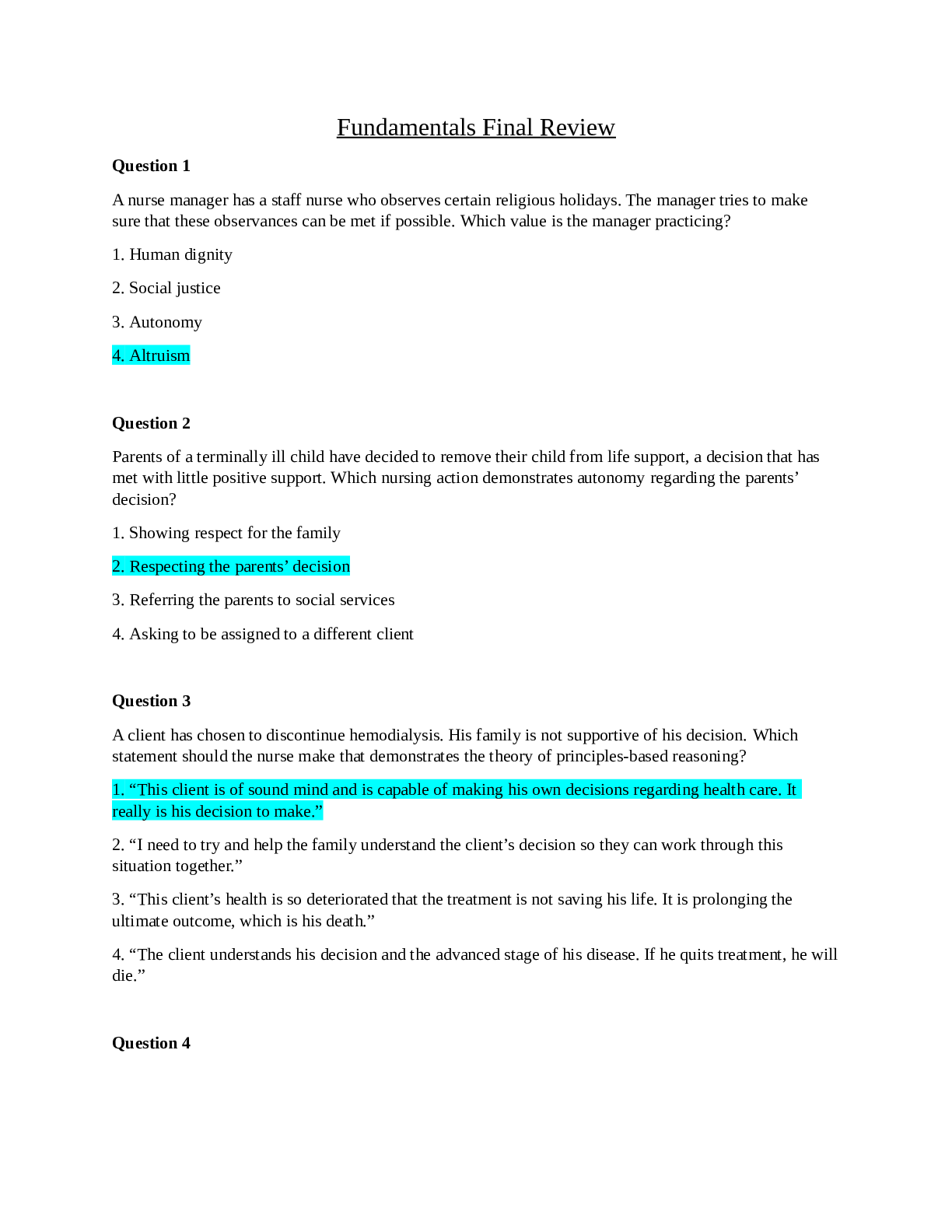
Reviews( 0 )
Document information
Connected school, study & course
About the document
Uploaded On
Nov 08, 2022
Number of pages
39
Written in
Additional information
This document has been written for:
Uploaded
Nov 08, 2022
Downloads
0
Views
337


